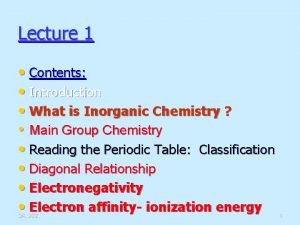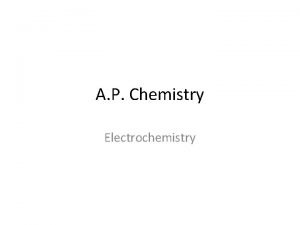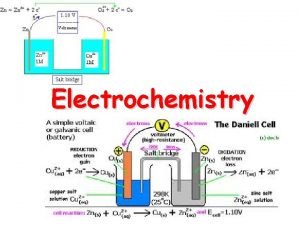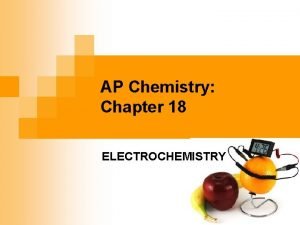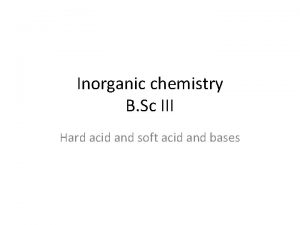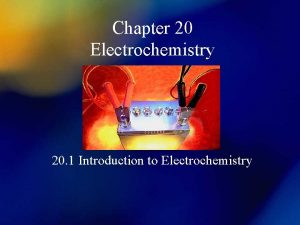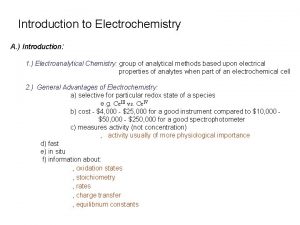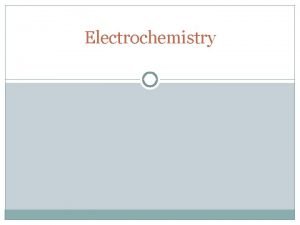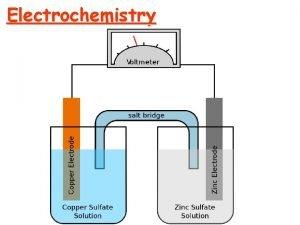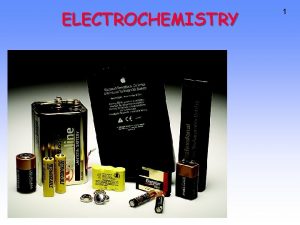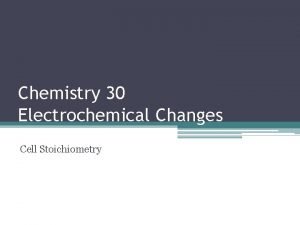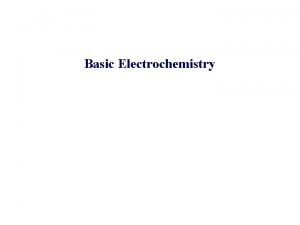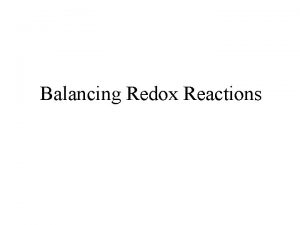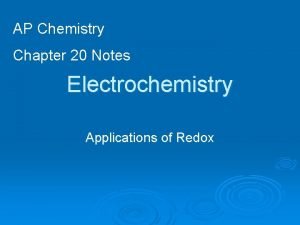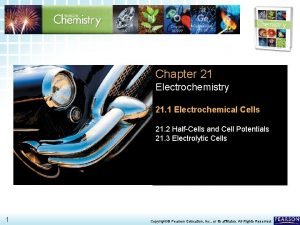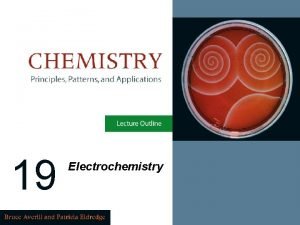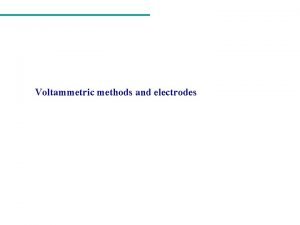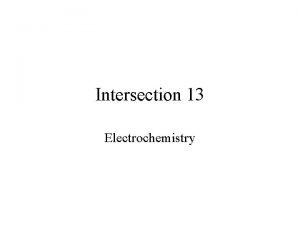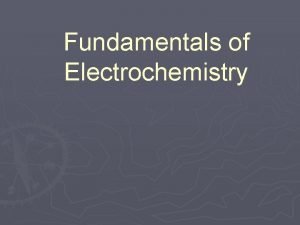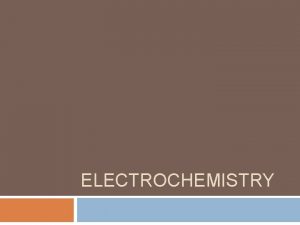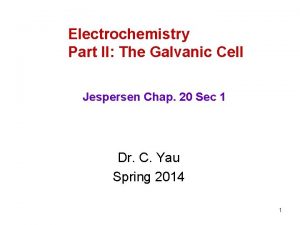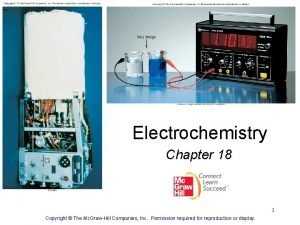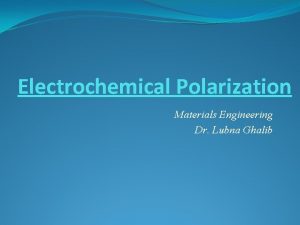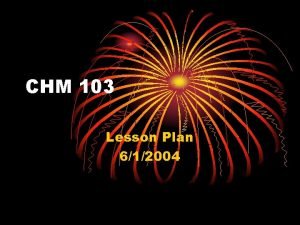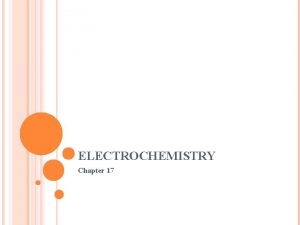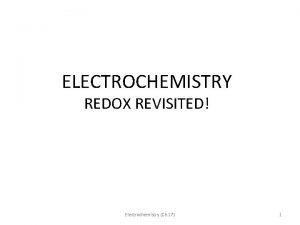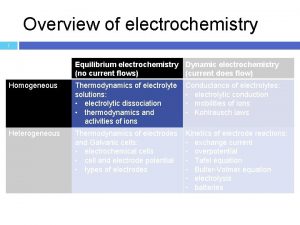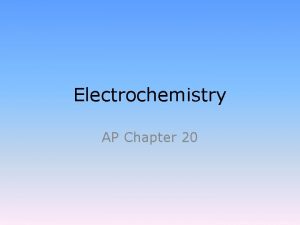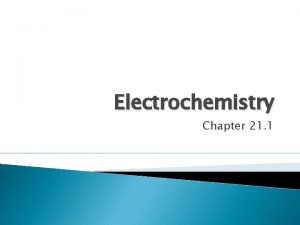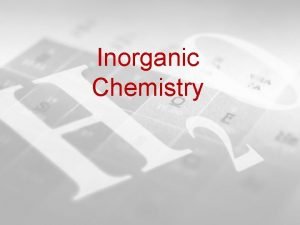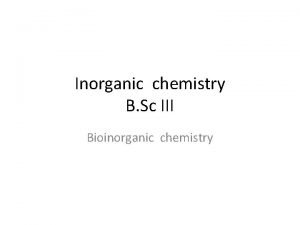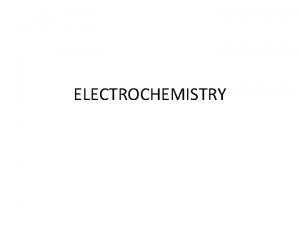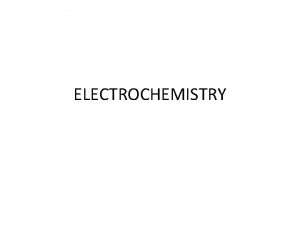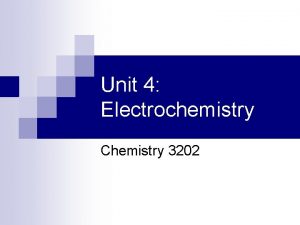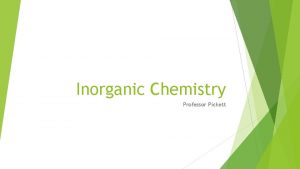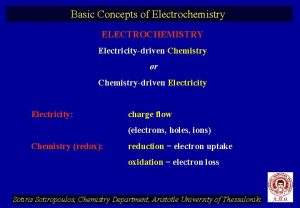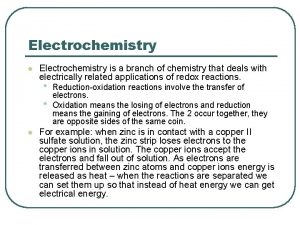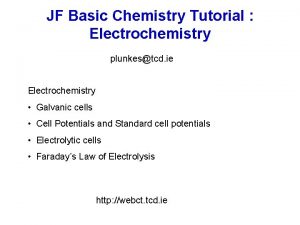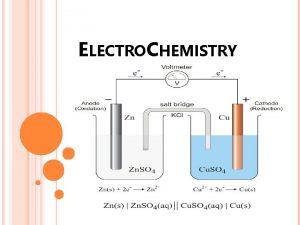An Introduction to Electrochemistry in Inorganic Chemistry Or





![[Cu(OH 2)5]2+ (aq) [Cu(OH 2)2]+ (aq) Cu [Cu(NH 3)4]2+ (aq) [Cu(NH 3)2]+ (aq) Cu [Cu(OH 2)5]2+ (aq) [Cu(OH 2)2]+ (aq) Cu [Cu(NH 3)4]2+ (aq) [Cu(NH 3)2]+ (aq) Cu](https://slidetodoc.com/presentation_image/1440a41768e3f61d260031b2e3afeb62/image-6.jpg)













![[2 Fe] Ferredoxin oxidized Spinach ferredoxin (1 A 70) from Spinacia oleracea at 1. [2 Fe] Ferredoxin oxidized Spinach ferredoxin (1 A 70) from Spinacia oleracea at 1.](https://slidetodoc.com/presentation_image/1440a41768e3f61d260031b2e3afeb62/image-20.jpg)
![[4 Fe] Iron Proteins (1 BLU) from Chromatim vinosum at 2. 1Å (1 IUA) [4 Fe] Iron Proteins (1 BLU) from Chromatim vinosum at 2. 1Å (1 IUA)](https://slidetodoc.com/presentation_image/1440a41768e3f61d260031b2e3afeb62/image-21.jpg)











![Superoxide Dismutase [Cu. Zn. SOD] Superoxide Dismutase [Cu. Zn. SOD]](https://slidetodoc.com/presentation_image/1440a41768e3f61d260031b2e3afeb62/image-33.jpg)

- Slides: 34

An Introduction to Electrochemistry in Inorganic Chemistry Or Quack…. I see a duck




![CuOH 252 aq CuOH 22 aq Cu CuNH 342 aq CuNH 32 aq Cu [Cu(OH 2)5]2+ (aq) [Cu(OH 2)2]+ (aq) Cu [Cu(NH 3)4]2+ (aq) [Cu(NH 3)2]+ (aq) Cu](https://slidetodoc.com/presentation_image/1440a41768e3f61d260031b2e3afeb62/image-6.jpg)
[Cu(OH 2)5]2+ (aq) [Cu(OH 2)2]+ (aq) Cu [Cu(NH 3)4]2+ (aq) [Cu(NH 3)2]+ (aq) Cu

Now we react the Cu(II) with a series of phenanthroline-based ligands phenanthroline 4, 7 -dimethylphenanthroline 2, 9 -dimethylphenanthroline Eo for [Cu. L 2]2+/[Cu. L 2]+ (Volts) 2, 9 -di-Mephen 0. 823 V 4, 7 -di-Mephen 0. 256 V phen 0. 322 V



Now we react the Cu(II) with a series of phenanthroline-based ligands phenanthroline 4, 7 -dimethylphenanthroline 2, 9 -dimethylphenanthroline Eo for [Cu. L 2]2+/[Cu. L 2]+ (Volts) 2, 9 -di-Mephen 0. 823 V 4, 7 -di-Mephen 0. 256 V phen 0. 322 V


Ligand’s Influence on Redox Potential

Influence of coordinated atoms on redox potential



THERE’S METALS IN THERE!!!!!

Electron transport chain Follows Krebs Cycle Results in oxidative phosphorylation Yes! Every Step uses a metalloenzyme

Redox Potential for Electron Transport Proteins

Rubredoxin (Rd) Oxidized rubredoxin (1 IRO) from Clostridum pasterurianum at 1. 1Å
![2 Fe Ferredoxin oxidized Spinach ferredoxin 1 A 70 from Spinacia oleracea at 1 [2 Fe] Ferredoxin oxidized Spinach ferredoxin (1 A 70) from Spinacia oleracea at 1.](https://slidetodoc.com/presentation_image/1440a41768e3f61d260031b2e3afeb62/image-20.jpg)
[2 Fe] Ferredoxin oxidized Spinach ferredoxin (1 A 70) from Spinacia oleracea at 1. 7Å
![4 Fe Iron Proteins 1 BLU from Chromatim vinosum at 2 1Å 1 IUA [4 Fe] Iron Proteins (1 BLU) from Chromatim vinosum at 2. 1Å (1 IUA)](https://slidetodoc.com/presentation_image/1440a41768e3f61d260031b2e3afeb62/image-21.jpg)
[4 Fe] Iron Proteins (1 BLU) from Chromatim vinosum at 2. 1Å (1 IUA) from Thermochromatium tepidum at 0. 8Å




So, the more negative the reduction potential is, the easier a reductant can reduce an oxidant and The more positive the reductive potential is, the easier an oxidant can oxidize a reductant The difference in reduction potential must be important


Reduction Potential Difference = Eº Eº = E° (acceptor) - E° (donor) measured in volts. The more positive the reduction potential difference is, the easier the redox reaction Work can be derived from the transfer of electrons and the ETS can be used to synthesize ATP.

The reduction potential can be related to free energy change by: Gº = -n. F Eº where n = # electrons transferred = 1, 2, 3 F = 96. 5 k. J/volt, called the Faraday constant

********************************** Table of Standard Reduction Potentials --- Oxidant + e- reductant -- e. g. , M&v. H, 3 rd ed. , p. 527 Note: oxidants can oxidize every compound with less positive voltage -- (above it in Table) reductants can reduce every compound with a less negative voltage -- (below it in Table) ***********************************

Standard Reduction Potential Oxidant Reductant n Eº, v NAD+ NADH 2 -0. 32 acetaldehyde ethanol 2 -0. 20 pyruvate lactate 2 -0. 19 oxaloacetate malate 2 -0. 17 1/2 O 2+2 H+ H 2 O 2 +0. 82

Redox Function Thermodynamics = redox potential: (DG = -n. FE 0) • ionization energy - electronic structure a) HOMO/LUMO - redox active orbital energy (stronger metal-ligand bonding raises the orbital energy easier to oxidize potential goes down) b) metal Zeff - all orbital energy levels (stronger ligand donation lower Zeff raised d-orbitals. . . ) c) electron relaxation - allow for orbital reorg. after redox (creation of a hole upon oxidation passive electrons shift larger thermodynamic driving force potential goes down)

-- Electrons can move through a chain of donors and acceptors -- In the electron transport chain, electrons flow down a gradient. -- Electrons move from a carrier with low reduction potential (high tendency to donate electrons) toward carriers with higher reduction potential (high tendency to accept electrons).
![Superoxide Dismutase Cu Zn SOD Superoxide Dismutase [Cu. Zn. SOD]](https://slidetodoc.com/presentation_image/1440a41768e3f61d260031b2e3afeb62/image-33.jpg)
Superoxide Dismutase [Cu. Zn. SOD]

12 Influenceson Redoxpotential: 1)Metalcenter 2 )Electrostatic (ligand charge)3)σ/π-Donor strength of ligand (p. Ka)4)π-Acceptor strength of ligand 5)Spin state 6)Steric factors/ constraints (enthatic state)How can a protein chain generate these diverse redox potentials?
 Organic vs inorganic chemistry
Organic vs inorganic chemistry Pharmaceutical inorganic chemistry chapter 1
Pharmaceutical inorganic chemistry chapter 1 Introduction to inorganic chemistry
Introduction to inorganic chemistry Ap chemistry chapter 18 electrochemistry test
Ap chemistry chapter 18 electrochemistry test Electrochemistry ap chemistry
Electrochemistry ap chemistry What is electrochemistry in chemistry
What is electrochemistry in chemistry What is electrochemistry
What is electrochemistry Ap chemistry ced
Ap chemistry ced Advanced inorganic chemistry lecture notes
Advanced inorganic chemistry lecture notes Is ch4o organic or inorganic
Is ch4o organic or inorganic What is fajans rule
What is fajans rule Introduction of electrochemistry
Introduction of electrochemistry Electrochemistry formulas
Electrochemistry formulas Ib organic chemistry
Ib organic chemistry Basic chemistry tutorial
Basic chemistry tutorial Transport no. in electrochemistry
Transport no. in electrochemistry Electrochemistry tutorial
Electrochemistry tutorial Electrochem equations
Electrochem equations Electrochemistry balancing equations
Electrochemistry balancing equations Electrochemistry stoichiometry
Electrochemistry stoichiometry Khan academy balancing equations
Khan academy balancing equations Ir drop
Ir drop Balancing redox reactions
Balancing redox reactions Chapter 20 review electrochemistry
Chapter 20 review electrochemistry Redox half reactions
Redox half reactions Cell chapter 21
Cell chapter 21 Equilibrium constant formula electrochemistry
Equilibrium constant formula electrochemistry Electroanalytical methods
Electroanalytical methods Electrolysis table
Electrolysis table Fundamentals of electrochemistry
Fundamentals of electrochemistry What is electrochemistry
What is electrochemistry Kno3 salt bridge
Kno3 salt bridge Diagonal rule electrochemistry
Diagonal rule electrochemistry What is polarization in electrochemistry
What is polarization in electrochemistry Electrochemistry lesson
Electrochemistry lesson


